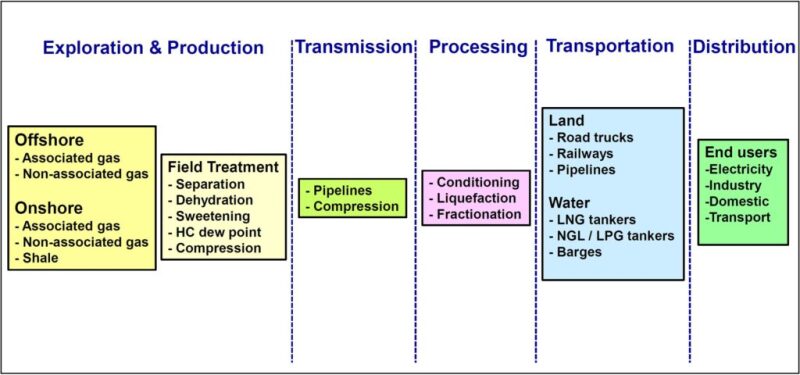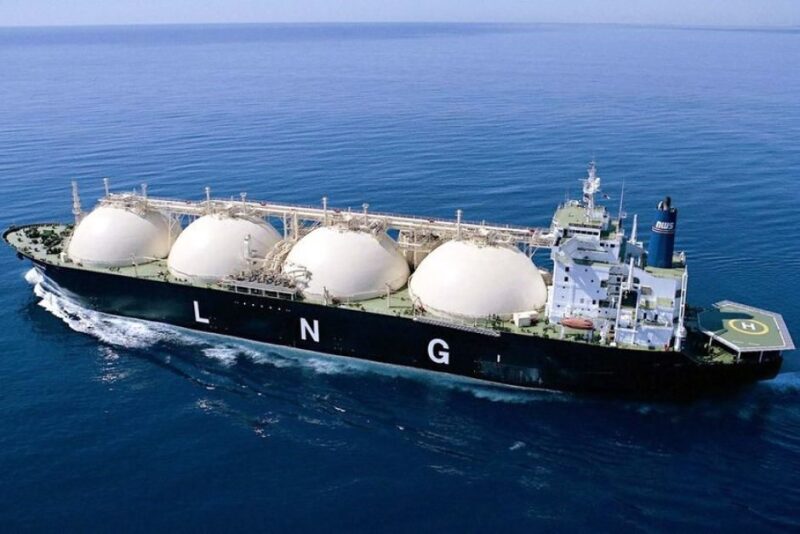As we ring in a new year, it is the inevitable time to review the expected future changes in energy supply and demand. Natural gas is considered the most environmentally friendly fossil fuel and is widely regarded as a bridging fuel to a low-carbon future.
This article reviews data published by different organizations on the short- and long-term outlook for the industry, with a particular emphasis on natural gas.
Natural Gas Supply Chain
A simplified block diagram of the natural gas supply chain from the well to the market is shown in Fig. 1. The extent of field treatment and plant processing of natural gas and the type of transport for moving natural gas liquids depend on many factors such as the composition of the produced hydrocarbon stream, proximity to end users, market conditions, and available infrastructure.

Natural gas is a versatile fuel and supplies 22% of the energy used worldwide. It makes up nearly a quarter of electricity generation and plays a crucial role as a feedstock for industry.
The Cleanest Fossil Fuel
Burning natural gas for energy results in fewer emissions of nearly all types of air pollutants and carbon dioxide (CO2) than burning coal or petroleum products to produce an equal amount of energy.
The table compares the amounts of carbon dioxide produced per million British thermal units (MMBtu) of various fossil fuels.
| MMBtu | Pounds of CO2 |
|---|---|
| Natural Gas | 117 |
| Distillate Fuel Oil | 160 |
| Coal | 200 |
Source: US Energy Information Administration.
The clean-burning properties of natural gas have contributed to increased natural gas use for electricity generation and as a transportation fuel for fleet vehicles in the United States.
IEA 2018 World Energy Outlook
Last October, the Paris-based International Energy Agency (IEA) published the latest edition of the World Energy Outlook, its flagship publication.
IEA reports that even though global energy needs will rise more slowly than in the past, the energy needs are still expected to expand by 30% between today and 2040. This is equivalent to adding another China and India to today’s global demand.
IEA points out that in meeting the world future energy demands, the lead is taken by
Natural gas
Rapid rise of renewables
Improvement in energy efficiency
Gas will grow faster than oil and coal over the next 5 years, helped by low prices, ample supply, and its role in reducing air pollution and other emissions. In the 5-year forecast to 2022, gas demand will grow at 1.6% per year.
EIA Short-Term Forecast
The US Energy Information Administration (EIA) publishes short-term energy outlooks on a monthly basis. In its short-term energy outlook released in December 2017, EIA forecast Brent spot prices to average $57/bbl in 2018, up from an average of $54/bbl in 2017. WTI crude oil prices are forecast to average $4/bbl lower than Brent prices in 2018.
Spot pricing of natural gas in the US is reported at regional hubs. These hubs are in general located at the intersection of major pipeline systems. Natural gas is often benchmark priced at the Henry Hub in Louisiana.
The expected growth in natural gas exports and domestic natural gas consumption in 2018 contribute to an increase in EIA's forecast of the Henry Hub natural gas spot price from an annual average of $3.01/MMBtu in 2017 to $3.12/MMBtu in 2018.
The Growing Role of LNG
The global natural gas market is growing, driven by the availability of shale gas and the increase in the liquefied natural gas (LNG) trade. LNG provides a viable route to monetize large gas reserves in remote locations such as Sub-Saharan Africa which have no significant markets nearby and only limited connectivity to existing demand centers (2017 DNV).

Shell notes that LNG is rapidly playing a bigger role in the energy mix and the market for it is expected to grow at around 5% annually. Global demand could increase from its current level of about 240 million tons per annum (mtpa) to around 430 mtpa in 2025. LNG trade is changing to meet the evolving needs of buyers, including shorter-term and lower-volume contracts.
In North America, the shale gas revolution established the US as the world’s leading natural gas producer. By the mid-2020s, the US is forecast to overtake Qatar and become the world’s largest LNG exporter.
Shift Toward Gas-Based Economy
Some countries, such as Canada, France, and the UK have plans to phase out coal-fired generation. Others have given priority to move toward a gas-based economy.
International oil companies, such as BP, Chevron, ExxonMobil, Shell, and Total have all signaled intent to increase the share of gas in their reserves. A case in point is the Shell acquisition of BG Group.
Companies are investigating cost-effective solutions to create value from flared gas (Lo Brutto and Layfield 2017) and examining various technologies to transport gas from remote offshore fields (Saavedra 2017).
This increased growth in natural gas use will result in more investment in both the short and long term across the supply chain of natural gas.
Security of Natural Gas Supply
While the gas markets are currently well-supplied, the transformation of natural gas markets from the regional to the global level with interdependencies of suppliers and consumers in different regions of the world is not without challenges. The IEA’s Global Gas Security Review provides an extensive analysis of recent gas balancing issues and risks with related policy developments linked to security of supply.
Events over the past year have also shown that natural gas security of supply cannot be taken for granted and remains a live issue, in spite of a loose overall supply environment.
In January, a cold snap and delays in LNG shipments led to gas supply emergencies in southern Europe.
In April, the government of Australia announced the introduction of a Domestic Gas Security Mechanism in relation to certain exporters of LNG.
In June, several neighboring countries broke off diplomatic relations with Qatar, currently the world’s largest exporter of LNG.
In August, Hurricane Harvey hit Texas, causing major risk of oil and gas production capacity shut-ins and associated threats to LNG exports.
In summary, natural gas is the only fossil fuel that will maintain its share in the energy mix of the coming decades, mainly supported by policies to reduce air pollution and greenhouse gas emissions.
For Further Reading
OTC 27939. 2017. Application of Gas Industrial Technologies Offshore by C.G. Saavedra.
OMC-2017-776. 2017. Exploring Technologies and Concepts for Creating Value From Flared and Vented Gas by F.M. Lo Brutto and M. Layfield.
DNV. 2017. Oil and Gas Forecast to 2050, Energy Transition Outlook 2017.
IEA. 2017. Global Gas Security Review.
IEA. 2017. World Energy Outlook.


